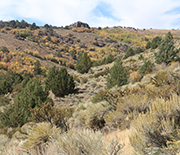News Release 18-064
In drought and heavy rains, ecosystems function like information communication networks
Connectivity explains ecosystem responses to extreme events

Scientists studied ecosystem connectivity at Idaho's Reynolds Creek CZO.
August 27, 2018
This material is available primarily for archival purposes. Telephone numbers or other contact information may be out of date; please see current contact information at media contacts.
Find related stories on NSF's Critical Zone Observatories.
How is a telecommunications network like an ecosystem?
Tree canopies and the running streams below, or coral reefs and the ocean waters that flow around them, are interconnected components of a larger whole: an ecosystem. These ecosystem parts are in communication with one another, scientists have learned, via signals transmitted among earth, air and water.
This idea has led to new ways of tracking how precipitation alters interactions among the atmosphere, vegetation and soil, according to researchers reporting new findings this week in the journal Proceedings of the National Academy of Sciences.
Scientists affiliated with two National Science Foundation (NSF) Critical Zone Observatory (CZO) sites in the Western U.S. -- the NSF Reynolds Creek CZO in Idaho and the NSF Southern Sierra CZO in California -- conducted the research.
"The results show the ways in which watersheds respond to precipitation disturbances, in this case rainfall and drought," said Richard Yuretich, NSF CZO program director. "The information is important to predicting how ecosystems will respond to future extreme events."
The researchers gathered data for changes in flows of heat, soil moisture and carbon -- known as fluxes -- before, during and after prolonged rainfall and droughts.
The Reynolds Creek CZO site experienced several days of rain in July 2015. The Southern Sierra CZO site endured a multi-year drought beginning in 2012.
"These events send information through connected components of ecosystems, similar to the way information flows through telecommunication networks," said scientist Praveen Kumar of the University of Illinois at Urbana-Champaign and a co-author of the paper.
"This kind of analysis is new to ecological and hydrologic studies and lets us study changes in the level of connectivity among different components, and whether responses are site-specific or common across different ecosystems," Kumar said.
A particular aspect that made this study unique, the researchers said, was their ability to obtain data from multiple stations placed at varying elevations at each site.
Data collection stations are usually far apart from each other, which can make it difficult to perform comparative analyses, according to Kumar.
"At the Idaho site, we saw increased connectivity between the atmosphere and the soil in the period directly after rainfall," said scientist Allison Goodwell of the University of Colorado, Denver, and lead author of the study. "At the Southern Sierra site, we found that heat and carbon fluxes responded to the drought in different ways, and that connectivity varied between high- and low-elevation sites."
Although the field sites and data are from different ecosystems, time periods and weather disturbances, the study provides insights into how connectivity influences fluxes, the researchers said.
Stronger connectivity alters how rainfall affects moisture, heat and carbon fluxes in ecosystems, as well as the progression from early to late-stage drought.
Other researchers involved in the study were Aaron Fellows and Gerald Flerchinger of the U.S. Department of Agriculture.
-NSF-
-
The Southern Sierra CZO was also a research site in the study.
Credit and Larger Version -
Earth's critical zone extends from above the tree canopy to bedrock.
Credit and Larger Version -
NSF CZO sites are located in watersheds from coast to coast across the U.S.
Credit and Larger Version -
Researchers at the Reynolds Creek CZO site studied mountain big sagebrush.
Credit and Larger Version -
What stories they tell: Jeffrey pines in the southern Sierras offer ecosystem connectivity clues.
Credit and Larger Version
Media Contacts
Cheryl Dybas, NSF, (703) 292-7734, email: cdybas@nsf.gov
Lois Yoksoulian, UIUC, (217) 244-2788, email: leyok@illinois.edu
The U.S. National Science Foundation propels the nation forward by advancing fundamental research in all fields of science and engineering. NSF supports research and people by providing facilities, instruments and funding to support their ingenuity and sustain the U.S. as a global leader in research and innovation. With a fiscal year 2023 budget of $9.5 billion, NSF funds reach all 50 states through grants to nearly 2,000 colleges, universities and institutions. Each year, NSF receives more than 40,000 competitive proposals and makes about 11,000 new awards. Those awards include support for cooperative research with industry, Arctic and Antarctic research and operations, and U.S. participation in international scientific efforts.
Connect with us online
NSF website: nsf.gov
NSF News: nsf.gov/news
For News Media: nsf.gov/news/newsroom
Statistics: nsf.gov/statistics/
Awards database: nsf.gov/awardsearch/
Follow us on social
Twitter: twitter.com/NSF
Facebook: facebook.com/US.NSF
Instagram: instagram.com/nsfgov







